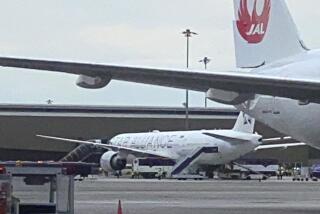No Wind-Shear Solution in Sight : Sensors Inadequate to Detect Air ‘Microbursts’
- Share via
WASHINGTON — Although the crash of Delta Air Lines Flight 191 has focused new attention on the only recently understood weather phenomenon of “microbursts” of wind, government and aviation safety experts say that a full-scale solution to the problem appears to be years away.
If a sudden downdraft sent the jumbo jet slamming into the ground short of the runway Friday night, as some speculate, low-level sensing equipment at Dallas-Fort Worth Airport failed to detect it.
“It looks like a very localized system . . . probably a severe weather situation on the approach that maybe the controller or crew weren’t aware of,” said one senior federal investigator at the crash site.
The cause of the crash remains undetermined, but speculation has centered on wind shear--a sudden shift in wind speed and direction. It is believed that the aircraft encountered a wind-shear phenome non known as a microburst, a violent downdraft of air associated with thunderstorms.
In microburst-induced low-level wind shear, the downdraft spreads out horizontally as it hits the ground. An airplane that encounters a microburst at low altitude will first experience increasing head winds--which tend to carry it above its approach path to the airport--and then suddenly increasing tail winds, which rob it of lift and greatly increase its descent rate. If a pilot has corrected for the first effect, the second effect almost certainly will force the craft well below the approach path.
Because most microbursts are small and short-lived, their detection is considered especially difficult.
More Sensors Urged
Government researchers have recommended that Dallas and about 70 other airports nationwide that already use sensing equipment upgrade it by increasing the number of wind sensors and by bunching them more closely together. When different wind conditions occur at different sensors--small weathervane-shaped objects placed on poles of varying heights around the airport--air traffic controllers are alerted.
But safety experts investigating the Dallas crash note that these sensors detect only wind direction and speed--not actual turbulence.
More promising, they say, are sophisticated and expensive experimental Doppler radar systems, which can more accurately detect sudden changes in wind speed and direction and provide better data.
But FAA efforts to move ahead with such systems have been stalled by the White House Office of Management and Budget, which has postponed funding until fiscal 1987. And, even if the Delta crash speeds approval of the Dopplers, a full-scale system could be in place no sooner than 1989, government and aviation officials say.
In the Dallas crash, which killed 133 persons, investigators have theorized that an electrical storm containing microbursts moved in as the Delta jet was landing. The plane’s pilot, they speculate, may have been hampered in his effort to pull out of a violent shift in the wind because the control tower had ordered him to slow down to 150 knots from 210 to avoid overtaking a smaller jet.
According to this theory, when a microburst slammed into the Delta plane as it descended, it already was too low and moving too slowly to resist wind shear.
Frantic Warning
Although air controllers frantically told the doomed Lockheed L-1011, “Delta, go around!” these investigators say that the craft may already have struck the ground.
Moments earlier, the Delta pilot had made remarks that indicated he was not apprehensive about the weather conditions.
“We’re in the rain. It feels good,” the pilot was heard saying on the cockpit voice recorder recovered from the wreckage, Patrick Bursley, a member of the National Transportation Safety Board, said in a briefing Tuesday night.
About 15 minutes after the pilot was warned to “go around,” the Dallas airport’s automated wind-shear detection system issued an alarm that weather conditions were treacherous.
According to government statistics, 29 wind shear-related accidents have occurred since 1964. And, although these violent downbursts are not a new phenomenon, they were not identified until about eight years ago, when Dr. Tetsuya Theodore Fujita, a professor of geophysical sciences at the University of Chicago, analyzed a crash in New York that killed 113 persons.
HOW A “MICROBURST” CAN AFFECT AIRCRAFT A jet approaching a runway may be especially vulnerable to the phenomenon because of its reduced power and already low altitude. Unlike propeller driven planes, a jet encounters a slight delay in achieving lift after increasing power.
1. As sudden downdraft pours toward ground, it spreads horizontally. A plane entering the downdraft at first experiences lift as air speeds over its wings. 2. Plane passes under the center of the downdraft, where the wind direction changes. 3. At the other side of the draft, the plane loses lift as the tailwind reduces air speed over the wings. 4. The loss of lift, combined with the downward force of the microburst, can lead to a crash, especially if the plane is already at a low altitude.
More to Read
Sign up for Essential California
The most important California stories and recommendations in your inbox every morning.
You may occasionally receive promotional content from the Los Angeles Times.












